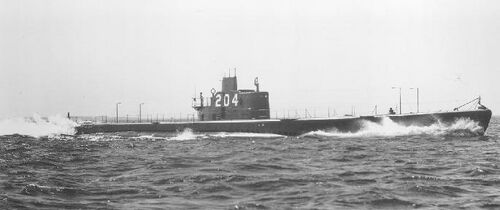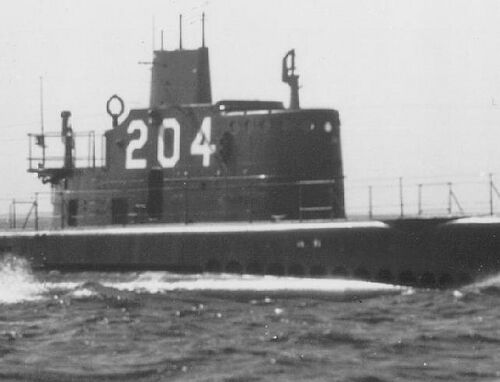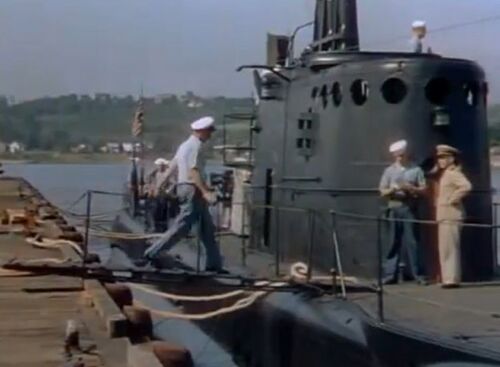204: Difference between revisions
Pbcjohnston (talk | contribs) SEO updates |
Pbcjohnston (talk | contribs) Added two photos |
||
| Line 5: | Line 5: | ||
=== <big>USS Mackerel (SS-204)</big> === | === <big>USS Mackerel (SS-204)</big> === | ||
[[File:Mackerel March 1941 broad port.jpg|left|500px]] | |||
<div style="text-align: justify;"><span style="color:#00008B">Mackerel on her builder's trials in Long Island Sound, March 22, 1941. Mackerel had been built with the aft end of her fairwater already cut down, providing an excellent location for an additional M2 .50 caliber water cooled machine gun. She would later have a 3"/50 caliber Mk 6 gun added aft of the fairwater. | |||
<small>Photo from the U.S. National Archives via Historylink101.com.</small> | |||
[[File:Red bar sub new.jpg]] | |||
[[File:Mackerel March 1941.jpg|left|500px]] | |||
A port quarter view of Mackerel at rest during trials, March 22, 1941. The aft superstructure of this boat ran all the way to the tip of the stern, much like the Porpoise and Salmon/Sargo-class boats. Just aft of the periscope shears is a circular Radio Direction Finding (RDF) loop antenna. | |||
<small>Photo from the U.S. National Archives via Historylink101.com.</small> | |||
[[File:Red bar sub new.jpg]] | |||
[[File:204-2.jpg|left|500px]] | [[File:204-2.jpg|left|500px]] | ||
Mackerel underway at full speed during builder's trials in Long Island Sound, March 22, 1941. A full speed run on a measured mile was a required part of the trials. It proved that the submarine could make the speed that was specified in the contract, in this case a maximum of 16 knots. Mackerel had a direct drive propulsion train, where the main engines were clutched to the propeller shaft, which also ran through the main motors, which doubled as generators for battery charging. Clutches allowed the crew to either use the main engines for propulsion or for battery charging, or to declutch the main engine when running on the battery and motors while submerged. Unlike her fleet submarine sisters, Mackerel and Marlin had only two main engines. | |||
<small>USN photo # 19-N-23871 from the Bureau of Ships Collection in the U.S. National Archives.</small> | <small>USN photo # 19-N-23871 from the Bureau of Ships Collection in the U.S. National Archives.</small> | ||
Latest revision as of 15:03, 18 June 2025
USS Mackerel (SS-204)

Photo from the U.S. National Archives via Historylink101.com.

A port quarter view of Mackerel at rest during trials, March 22, 1941. The aft superstructure of this boat ran all the way to the tip of the stern, much like the Porpoise and Salmon/Sargo-class boats. Just aft of the periscope shears is a circular Radio Direction Finding (RDF) loop antenna.
Photo from the U.S. National Archives via Historylink101.com.

Mackerel underway at full speed during builder's trials in Long Island Sound, March 22, 1941. A full speed run on a measured mile was a required part of the trials. It proved that the submarine could make the speed that was specified in the contract, in this case a maximum of 16 knots. Mackerel had a direct drive propulsion train, where the main engines were clutched to the propeller shaft, which also ran through the main motors, which doubled as generators for battery charging. Clutches allowed the crew to either use the main engines for propulsion or for battery charging, or to declutch the main engine when running on the battery and motors while submerged. Unlike her fleet submarine sisters, Mackerel and Marlin had only two main engines.
USN photo # 19-N-23871 from the Bureau of Ships Collection in the U.S. National Archives.

USN photo # 19-N-23871 from the Bureau of Ships Collection in the U.S. National Archives.

Screenshot from the movie Crash Dive, by the webmasters.
Page created by:
Ric Hedman & David Johnston
1999 - 2023 - PigBoats.COM©
Mountlake Terrace, WA, Norfolk, VA
webmaster at pigboats dot com
